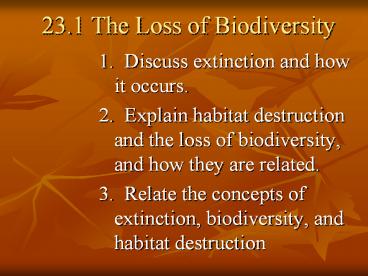23.1 The Loss of Biodiversity - PowerPoint PPT Presentation
1 / 14
Title:
23.1 The Loss of Biodiversity
Description:
Do the names Stegosaurus, Triceratops, and Tyrannosaurus rex sound familiar? These dinosaurs and many others roamed Earth millions of years ago. ... – PowerPoint PPT presentation
Number of Views:23
Avg rating:3.0/5.0
Title: 23.1 The Loss of Biodiversity
1
23.1 The Loss of Biodiversity
- 1. Discuss extinction and how it occurs.
- 2. Explain habitat destruction and the loss of
biodiversity, and how they are related. - 3. Relate the concepts of extinction,
biodiversity, and habitat destruction
2
The Loss of Biodiversity
- Do the names Stegosaurus, Triceratops, and
Tyrannosaurus rex sound familiar? These
dinosaurs and many others roamed Earth millions
of years ago. All that remains of the dinosaurs
are fossils. - Today, the lowland gorillas, several species
of whale, and countless plants and other
organisms are threatened with extinction. Human
activity is destroying many of Earths habitats.
As habitats disappear, the organisms adapted to
those habitats also disappear.
3
The Loss of Biodiversity
- Every organism is adapted to live in a certain
habitat. If a habitat is altered or destroyed,
the organisms adapted to that habitat must either
find a new habitat or die. - If a species is generalized, it may be able to
occupy another niche. Specialized species almost
always die with their habitats. - The disappearance of a species from all or part
of the species geographical range is called
extinction.
4
The Loss of Biodiversity
- When the last population of a species dies, some
diversity in the ecosystem is lost. Because the
extinction of a species affects factors such as
the flow of energy and matter and the habitats of
other organisms, a loss in biodiversity can upset
the balance, health, and stability of an
ecosystem.
5
Extinction
- Extinctions are a natural part of ecosystem
function. - More than 99 of the species that have lived on
Earth are extinct today. - All ecosystems change, and niches appear and
disappear with these changes. - Species that lack adaptations for survival in a
changing ecosystem become extinct. - Other species may evolve to fill new niches or
empty niches lived by extinct species.
6
Extinction
- Relatively short periods of time in which many
species die are called mass extinction. - Mass extinctions are typically followed by rapid
evolution as the few organisms that survive
evolve to fill vacant niches. - Earth may currently be experiencing another mass
extinction. The activities of one species
humans are causing many other species to become
extinct year after year.
7
Extinction
- Many human activities contribute to the
extinction of species. The most serious factor
is deforestation and other types of habitat
destruction - 50 - Habitat destruction and commercial
harvesting. - 18 - Hunting and poaching
- 16 - Alien species introduction
- 16 - Pollution, others
8
Loss of Habitat
- Extinctions and the resulting loss of
biodiversity often occur when humans destroy the
habitat of organisms. Disturbing the part of an
ecosystem that an organism needs to survive is
called habitat destruction. Cutting down all the
trees in a forest is one form of habitat
destruction.
9
Loss of Habitat
- Land development is another form of habitat
destruction. Draining swamps for housing
complexes, and altering wetlands for use as
resorts, marinas, and farmlands, destroy fragile
wetland habitats. - Changing the course of rivers by using dams to
control water flow can destroy aquatic habitats.
10
Loss of Habitat
- Native species can also be threatened by other
species that are introduced by humans. - Non-native species introduced to an area by
humans are called alien species. - For example, the water hyacinth is an ornamental
plant that was brought to Louisiana from South
America. In many ecosystems, the water hyacinth
has out-competed other plants for the resources
in the ecosystem.
11
Loss of Habitat
- Human activity is destroying or altering habitats
in al biomes. - The rate of biodiversity loss increases every
day. - As the human population grows, Earth will
continue to lose biodiversity as people alter m
ore habitats. As the number of humans increases,
the amount of space available to other organisms
declines.
12
The Endangered Species Act
- The main provisions of the Endangered Species Act
are - The United States Fish and Wildlife Service must
keep a list of all threatened and endangered
species. - Threatened or endangered animals may not be
caught or killed. - Threatened or endangered plants may not be
disturbed. - Threatened or endangered species and products
made from them may not be bought or sold. - The federal government may not construct any
project that jeopardizes endangered species. - The Fish and Wildlife Service must prepare a
species recover plan for each threatened or
endangered species. - http//www.fws.gov/endangered/
13
The Endangered Species Act
- Think About
- Many ecologists thing the Endangered Species Act
focuses too much on individual species. They
feel the emphasis should be on whole habitats,
not on individual species.
14
The Loss of BiodiversityHomework
- Modeling a Bald Eagle Population Activity (p
392). - Part Two find 2 examples from the plant kingdom
and 2 examples from the animal kingdom that are
now extinct in the state of New Jersey.































